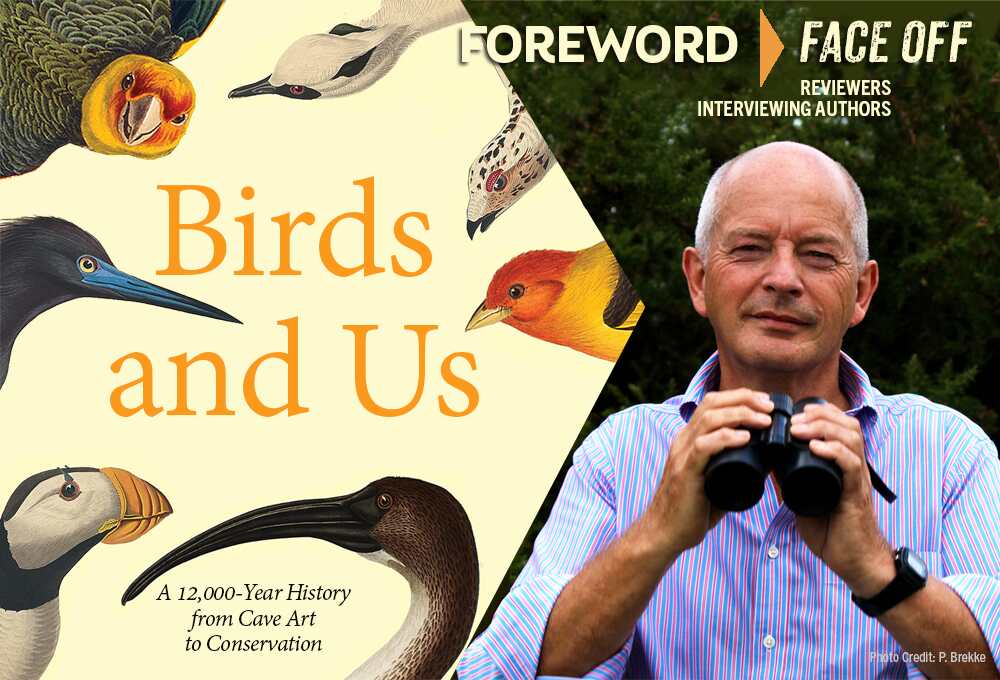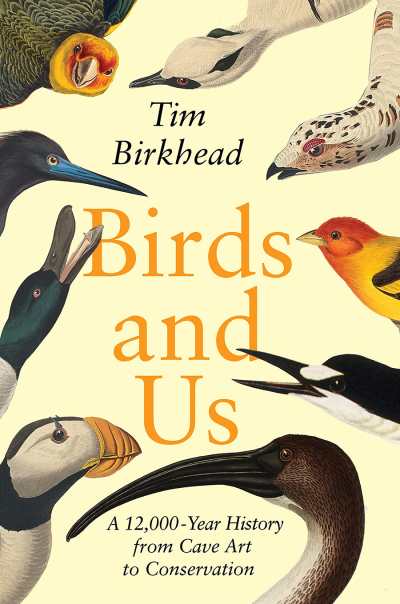Reviewer Matt Benzing Interviews Tim Birkhead, Author of Birds and Us: A 12,000-Year History from Cave Art to Conservation

Who doesn’t want to fly? Okay, you, sir, with a fear of heights, we get it. But the rest of us would happily give up our opposable thumbs to soar with the birds. Yes, California Condor, you lucky buzzard, we’re seriously jealous.

In Birds and Us: A 12,000-Year History from Cave Art to Conservation, Tim Birkhead turns that envy into admiration, offering an entrancing look at the history of the human-avian relationship. In his review for Foreword, Matt Benzing writes that Birkhead details “the bird’s flight through human art and culture, as well as our scientific, artistic, spiritual, and even culinary interest in birds.”
So much to talk about. Reviewer, let’s get this convo started.
You have many fascinating stories from history and prehistory in this book, but I’m sure you had even more that you encountered in your research that couldn’t make it into the book. What’s the most interesting example of human’s relationships with birds that didn’t make it into the book?
Previously in The Red Canary / A Brand New Bird (published in 2003) I discussed the role of bird keepers in the development of ornithology—I still think that these often-maligned people who have a very close relationship with birds, have played a crucial role in our understanding of birds. I have been inspired by conversations with bird keepers. One such conversation, regarding the monogamous nature of the Eurasian bullfinch, triggered off a decade of research for my research students and I, resulting in a far better understanding of the reproductive biology of birds.
You discuss the Roman delicacy of flamingo tongue, as well as other culinary bird uses that sound strange to modern western ears. Did you ever get to try flamingo tongue? What is the most surprising type of fowl you’ve sampled?
I discuss this in that flamingo section and (later) when my colleagues and I were abandoned on a remote island in Labrador, and ran out of food, we ate some auks.
What is the most impactful experience you’ve had interacting or even just observing a bird?
I have had many such experiences. In terms of the most emotional experience, it was again in Labrador just at the time guillemots and razorbills were fledging. A huge Atlantic swell made the sea so rough the birds wouldn’t leave. It was like this for three days; on the fourth day at around midday the swell started to subside and the birds, full of pent-up energy and desperate to leave, started to depart. Guillemots and razorbills normally fledge at dusk to avoid predatory gulls, so seeing them leave in broad daylight and in such vast numbers—because following the delay, they all leave pretty well simultaneously. Over 100,000 adult-chick pairs made their way to the sea calling incessantly to each other in an overwhelming auditory and visual spectacle. On and on it went, all afternoon, into the red sunset evening and the dark. As I lay in my bunk in the cabin that night, I listened as the chorus of calls faded away into the night as the birds dispersed into the Labrador Sea.
Bird watching seems to be an important part of what we now call “citizen science.” You discuss the history of this pastime in your book. How has the internet and the access to online databases changed birdwatching, and how does in impact the academic study of ornithology?
Science is often driven by technology, and ornithology is no different. The most striking example is our ability now to track birds. This has opened up entire new areas of discovery. As a result, we have witnessed revolution in our understanding of bird migration.
I’m originally from Cincinnati, where the last known passenger pigeon died in the Cincinnati Zoo. They even have a memorial to her there. Was the story of their extinction considered for the book?
Unfortunately not. I had to choose one iconic extinct bird and I plumped for the great auk.
Humanity seems to have a drive to dominate nature. You show examples of this with the extinction projects aimed at various species in societies as far removed as Tudor England and Mao’s China. Do you think we will ever outgrow this need to force our will onto the natural world?
Probably not, but as awareness of our dreadful effect on the plant grows, I am optimistic that we can begin to reduce our impact and rectify some of our errors.
It is easy for affluent western societies to react with horror at the hunting practices of traditional societies like the Faroe Islanders. Is there hypocrisy in this reaction? Are there ways to find a balance between protecting wildlife while also protecting the survival strategies of peoples whose global impact is minimal compared to our own?
I use the situation on the Faroes as an example of how in the past people were able to sustain themselves on birds without destroying their populations. That carefully managed balance has now been disrupted not only by climate change, but very recently also by avian influenza.
It is easy to understand the concerns of the Faroese people, that even in that remote location, they are affected—negatively—by events whose origins are far away and for which they are not responsible.
You close the book looking at Guillemots and their prospects for survival. Are you optimistic or pessimistic about the chances for our current biodiversity to survive the coming century?
We have to be optimistic, not defeatist. Everyone who cares for the environment has to keep fighting, maintaining the pressure on governments and businesses to take steps to ensure that there is a future for wildlife.
If we could bring back the Dodo would you be in favor of giving the poor bird a second chance?
It would be incredibly interesting to do so. The notion of de-extinction is of great interest and with the ongoing developments in molecular biology, it seems increasingly possible—not soon, but eventually. I’d love to see the dodo, the passenger pigeon, and most of all the great auk resurrected. In fact, my next book will look at this possibility in the greatest of all auks.
Matt Benzing
